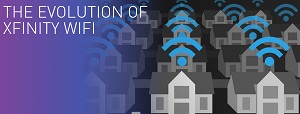Cable Show 2013: Comcast Turns Wireless Gateways Into Neighborhood Wi-Fi Hotspots

Washington -- Comcast is pushing ahead with an aggressive initiative to create “millions” of Wi-Fi neighborhood hotspots by broadcasting a new “xfinitywifi” signal, or SSID (service set identifier), in DOCSIS-powered wireless gateways deployed in customer homes.
Comcast said the new SSID will be completely separate and distinct from the home subscriber’s private and secure home Wi-Fi signal/SSID, and that the strategy will complement the MSO’s public Wi-Fi network deployments underway in Washington, D.C.; Philadelphia; Boston; Northern Virginia, Chicago, Atlanta; Delaware; and California.
These new neighborhood hotspots, like those public hotspots deployed on the Comcast network, are accessible to Comcast high-speed Internet customers; they’ll need to access the xfinitywifi signal using their login credentials.
Comcast, the first major U.S. MSO to apply a neighborhood Wi-Fi strategy involving gateways, is hitting on a trend that is already popular in Europe. Among recent examples, Ziggo, the largest MSO in the Netherlands, is moving forward on a plan to turn more than 1 million wireless cable modem gateways into quasi-public hotspots by this September.
For now, Comcast is making the neighborhood Wi-Fi signals available only to its own customers and not extending access to customers of MSOs that are part of the broader “CableWiFi” roaming initiative, which currently involves Cablevision Systems, Time Warner Cable, Bright House Networks, and Cox Communications. Those MSOs, including Comcast, have already deployed more than 150,000 public hotspots so far.
Comcast launched a neighborhood hotspot market trial last year in parts of Pennsylvania, New Jersey, Northern Virginia, and the greater Washington, D.C. metro area. The MSO estimates that more than 100,000 gateways in those markets already support the new, public-facing xfinitywifi signals.
The MSO sees the initiative as a way to extend broadband access when its cable modem customers are away from home.
Multichannel Newsletter
The smarter way to stay on top of the multichannel video marketplace. Sign up below.
“Wi-Fi is at the center of our strategy to offer our customers the best online experience, whether it’s the fastest Wi-Fi experience in the home, or a fast and reliable Wi-Fi environment outside the home,” Tom Nagel, senior vice president of business development for Comcast Cable, said, in a statement. “Our neighborhood hotspot initiative is an aggressive plan to give our Xfinity Internet customers even more ways to securely and seamlessly connect to the Internet, with the potential for millions of hotspots to support for their growing number of wireless devices.”
Comcast is enabling this public/private Wi-Fi split using a new batch of gateway firmware, noting that the customer’s home service flow and the public Wi-Fi hotspot service flow will be partitioned, meaning that the speed of the home subscriber’s broadband service will not be affected by the new neighborhood Wi-Fi SSID.
In this early phase, Comcast estimates that it is provisioning 15 Mbps to 20 Mbps for the public-facing xfinitywifi signal coming out of each gateway.
Comcast is alerting customers through e-mails and letters when the new firmware is installed, and does let subscribers opt-out of the neighborhood Wi-Fi program if they so desire. Comcast said only a small fraction of customers in the trial markets opted out of the project. Ziggo found similar results during its initial trials in the Netherlands.
Comcast didn’t say when it will deploy the new firmware in other markets, but expects to ramp the process up over the next six months or so. The firmware will be rolled into a range of gateways with on-board Wi-Fi, including a new “XB3” model made by Cisco Systems and other vendors that match 802.11n Wi-Fi with a DOCSIS 3.0 cable modem that can bond up to 16 downstream channels.
